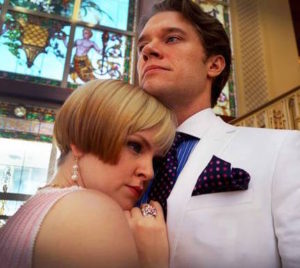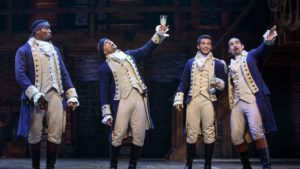 Paul Desmond and Dave Brubeck play “Balcony Rock” at a 1976 reunion concert in Boston:
Paul Desmond and Dave Brubeck play “Balcony Rock” at a 1976 reunion concert in Boston:
(This is the latest in a series of arts-related videos that appear in this space each Monday, Wednesday, and Friday)
Terry Teachout on the arts in New York City
In today’s Wall Street Journal I review a Florida production of a new stage version of The Great Gatsby. Here’s an excerpt.
* * *
“The Great Gatsby” is a novel short enough to aspire to perfection and good enough to approach it. Every character is memorable, every sentence unostentatiously lapidary. In addition, it says something essential about America’s national character, which F. Scott Fitzgerald embodied in the elusive person of Jay Gatsby, the original “Mr. Nobody from Nowhere.” A self-defined, self-deluding man, he made himself over into what he longed to be—and paid the price for it. No surprise, then, that so many attempts have been made to translate “Gatsby” into other media, including John Harbison’s 1999 operatic adaptation and a half-dozen different screen versions. All of them, however, have been futile, partly because of the nature of the novel, which is an intimate, almost undramatic conversation piece, and partly because Fitzgerald’s quicksilver tale needs nothing more than words on the page to make its indelible effect.
 Nevertheless, Simon Levy has given it yet another try with his stage version of “Gatsby,” which received its premiere in 2006 at Minneapolis’ Guthrie Theater and has now made its way south to Florida’s Orlando Shakespeare Theater, a regional company that goes in for staged versions of classic novels (“Nicholas Nickleby,” “Pride and Prejudice” and “To Kill a Mockingbird” have all been mounted there with memorable skill in recent seasons). Mr. Levy’s “Gatsby” is short—two acts, two hours—and straightforward to a fault and beyond, a plot-intensive, dialogue-driven adaptation. Virtually all of Nick Carraway’s first-person narration, the wellspring of the novel’s color and character, has been ruthlessly excised. Imagine listening to a familiar opera performed with piano accompaniment and you’ll get the idea: The “tunes” are still there, but there’s not much left in the way of atmosphere.
Nevertheless, Simon Levy has given it yet another try with his stage version of “Gatsby,” which received its premiere in 2006 at Minneapolis’ Guthrie Theater and has now made its way south to Florida’s Orlando Shakespeare Theater, a regional company that goes in for staged versions of classic novels (“Nicholas Nickleby,” “Pride and Prejudice” and “To Kill a Mockingbird” have all been mounted there with memorable skill in recent seasons). Mr. Levy’s “Gatsby” is short—two acts, two hours—and straightforward to a fault and beyond, a plot-intensive, dialogue-driven adaptation. Virtually all of Nick Carraway’s first-person narration, the wellspring of the novel’s color and character, has been ruthlessly excised. Imagine listening to a familiar opera performed with piano accompaniment and you’ll get the idea: The “tunes” are still there, but there’s not much left in the way of atmosphere.
Up to a point, good acting can offset such grievous losses, and Matthew Goodrich’s Errol Flynn-like performance in the title role is very fine. His cool, offhand poise is like an elegantly cut but threadbare suit through which you can see Gatsby’s longing and desperation….
* * *
Read the whole thing here.
Here’s my list of recommended Broadway, off-Broadway, and out-of-town shows, updated weekly. In all cases, I gave these shows favorable reviews (if sometimes qualifiedly so) in The Wall Street Journal when they opened. For more information, click on the title.
BROADWAY:
• Dear Evan Hansen (musical, PG-13, all shows sold out last week, reviewed here)
 • Hamilton (musical, PG-13, Broadway transfer of off-Broadway production, all shows sold out last week, reviewed here)
• Hamilton (musical, PG-13, Broadway transfer of off-Broadway production, all shows sold out last week, reviewed here)
• On Your Feet! (jukebox musical, G, reviewed here)
OFF BROADWAY:
• The Fantasticks (musical, G, suitable for children capable of enjoying a love story, reviewed here)
IN SARASOTA, FLA.:
• Born Yesterday (comedy, PG-13, closes April 15, reviewed here)
In today’s Wall Street Journal “Sightings” column I write about the California Symphony’s new millennial outreach initiative. Here’s an excerpt.
* * *
Everybody in the fine arts is asking the same question: How do you persuade millennials, accustomed as they are to the split-second convenience of hand-held on-demand entertainment, to get off their couches and see your shows? Some of the shrewdest answers are coming from the California Symphony, which has redesigned its website in response to the input of under-35 concertgoers.
 The California Symphony is a regional ensemble based in Walnut Creek, a suburb of San Francisco. Its official mission is “to become a 21st-century orchestra, making classical music relevant to those we serve, bringing in new audiences along the way.” To that end, the management has launched “Orchestra X,” a new program aimed at “a group of millennials and Gen-Xers that could or should go to orchestra concerts…but for whatever reason just doesn’t attend.” Locals who fit the profile were invited to attend the first concert of the season, paying just $5 to get in. Those who accepted the invitation visited the orchestra’s website, then wrote down their responses to the site and the concert. Afterward, they came to a pizza-and-beer party at which they “report[ed] back on their experience—the good, the bad, and the ugly.” The results were subsequently published on Medium, a youth-oriented app that runs stories written by its readers….
The California Symphony is a regional ensemble based in Walnut Creek, a suburb of San Francisco. Its official mission is “to become a 21st-century orchestra, making classical music relevant to those we serve, bringing in new audiences along the way.” To that end, the management has launched “Orchestra X,” a new program aimed at “a group of millennials and Gen-Xers that could or should go to orchestra concerts…but for whatever reason just doesn’t attend.” Locals who fit the profile were invited to attend the first concert of the season, paying just $5 to get in. Those who accepted the invitation visited the orchestra’s website, then wrote down their responses to the site and the concert. Afterward, they came to a pizza-and-beer party at which they “report[ed] back on their experience—the good, the bad, and the ugly.” The results were subsequently published on Medium, a youth-oriented app that runs stories written by its readers….
What the California Symphony discovered, in short, was that “almost every single piece of negative feedback was about something other than the performance.” Another key discovery was that it’s single-ticket buyers, not veteran subscribers, who are most likely to use the orchestra’s website. They’re less experienced in the sometimes arcane ways of classical concertgoing—but far from stupid: “We can be informative to smart, curious people who want to learn and want to know very much why each concert is special without dumbing it down. Casual and approachable does not equal dumb.”
Go to californiasymphony.org and you’ll see how the orchestra is responding to millennial input….
What is most striking about these changes is that you don’t have to be under 35 to appreciate them. Now that public-school arts education is on the way to becoming a thing of the distant past, they’re common-sense responses to the unmet needs of potential concertgoers of all ages…
* * *
Read the whole thing here.
A video featurette about the California Symphony’s Young American Composer-In-Residence program:
 James Cagney appears as the mystery guest on What’s My Line? This episode was originally telecast by CBS on May 15, 1960. The panelists are Bennett Cerf, Arlene Francis, Dorothy Kilgallen, and Gore Vidal and the host is John Charles Daly:
James Cagney appears as the mystery guest on What’s My Line? This episode was originally telecast by CBS on May 15, 1960. The panelists are Bennett Cerf, Arlene Francis, Dorothy Kilgallen, and Gore Vidal and the host is John Charles Daly:
(This is the latest in a series of arts-related videos that appear in this space each Monday, Wednesday, and Friday)
| M | T | W | T | F | S | S |
|---|---|---|---|---|---|---|
| 1 | 2 | 3 | 4 | 5 | 6 | |
| 7 | 8 | 9 | 10 | 11 | 12 | 13 |
| 14 | 15 | 16 | 17 | 18 | 19 | 20 |
| 21 | 22 | 23 | 24 | 25 | 26 | 27 |
| 28 | 29 | 30 | ||||
An ArtsJournal Blog